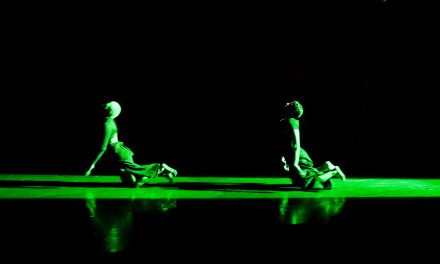Miguel Gutierrez is a much-celebrated dance and music performance artist. He was the recipient of a 2010 Foundation for Contemporary Arts grant, a 2010 John Simon Guggenheim Memorial Foundation Fellow, and in 2014 Gutierrez was one of the few dance artists chosen for the Whitney Biennial. He has also traveled nationally and internationally to lead workshops on his approach to creating art, plus he is a very talented singer and song writer.
So, why did Gutierrez’s performance of K-D-A-VER presented by the Los Angeles Performance Practice at Live Arts Los Angeles not hold together? By his own admission during the performance, Gutierrez pulled this production together in just six days, and sadly, it showed. There were sections that highlighted his many talents, and his verbal wit was prominent throughout. K-D-A-VER was, however, akin to looking at beautiful patches laid out to make a quilt but not having enough thread to sew them together.
K-D-A-VER was promoted as “a one night solo ritual/performance” to discuss the killing of Gutierrez’s very popular and long-running DEEP AEROBICS. Seated outside next to the Will Call table was the Los Angeles based visual and interdisciplinary performance artist, Marsian De Lellis, wearing a black veil and macabre make-up. He provided free black masks and funeral veils, as well as offering to paint the faces of those who were willing to dress for the death of DEEP AEROBICS.
Inside the performance space, a video of DEEP AEROBICS was projected against the back wall. Wearing a clown-like wig, white kitchen apron and red briefs, Gutierrez led a large group of people, dressed in as many varieties of costumes, move through a series of aerobic exercises. There was no sound which gave it the feel of watching a mad doctor lead his out-of-control inmates in an asylum.
After briefly speaking to the audience about the history of DEEP AEROBICS and why he wanted to kill it, Gutierrez instructed the audience to vacate the space while he set it up for the performance. What? I drove for almost an hour to sit for several minutes before being told to again wait outside. I was tempted to leave but resisted the urge.
Upon our return, the space had an overall surreal atmosphere about it. The studio was filled with fog and Gutierrez lay on his back with a helium filled balloon tied to his right big toe, speaking into a mic about how the subconscious is an illusion, and the illusion is real. He soon stood and walked around asking the audience to get back into their bodies and experience life, not just observe it. He asked them to sense their hands and feel more, sense their eyes and see more, etc. This was very appropriate for this current millennial generation who seems dependent on their laptops and cell phones.
The only set for this work was a small round table and chair. On it was a laptop which Gutierrez used to produce electronic music and to read about his philosophies on life. With several punches of different buttons on the laptop, layers of a throbbing disco beat filled the room and Gutierrez performed a repetitive aerobics dance until exhausted, thus finishing off the aerobics instructor.
A loud drone-like score played while Gutierrez stood quite still. His body soon began to quietly twitch prior to his movements morphing into wild thrashing about as if he had lost control of his body. It was not clear what force or forces were driving this madness, but when the music abruptly ended, Gutierrez also stopped and simply walked over to the table and sat down. Was his temporary madness forgotten, gone unnoticed or simply accepted? Not clear.
Eventually, the fog machine began spewing out mist again. Unfortunately for some in the audience, it had been placed directly beneath where they were seated. Handkerchiefs appeared to cover faces, and programs were used as fans. I am certain that this was not the type of audience participation that these people were expecting.
There was audience participation. Gutierrez invited the audience to lie on the floor, close their eyes and meditate while he spoke and different shades of red, blue and green revolved against the back wall. He chose a young man from the audience, whispered instructions into his ear and the two moved across the space locked in a passionate kiss and gently caressing one another. It was nice to see that the LA audience was not shocked by this public display of same sex affection, but how it would play in Peoria, one can only imagine. It was Gutierrez’s birthday, so he asked a group of people to hoist him over their heads and carry him around while he read a segment from a theology paper from his cell phone.
With Gutierrez waiting in a push-up position, a woman from the audience was directed to lie on her back underneath him. He lowered himself on top of her and began shaking and crying as music blasted out what sounded like bombs going off or lightning bolts striking nearby. Leaving her, the work ended with Gutierrez crawling across the space while singing a lonely but aggressive song about breaking up. A metaphor for divorcing DEEP AEROBICS. For the final verse, Gutierrez pulled down his briefs, exposing his bare butt, and used both hands to make it appear as if he were singing through his ass.
It was an appropriate finish to a rather disappointing evening. I was not convinced that we had witnessed the killing of DEEP AEROBICS or whether this was the birth of several unrelated ideas for a future project. I was certain, however, that Los Angeles had not experienced the best of Miguel Gutierrez.
The creative lighting was by Katelan Braymer and Sound Assistance was by Duncan Woodbury.
For more information on Miguel Gutierrez, click here.
Feature photo: Miguel Gutierrez – Photo: Ian Douglas
To view the L.A. Dance Chronicle Calendar of performances, click here.












